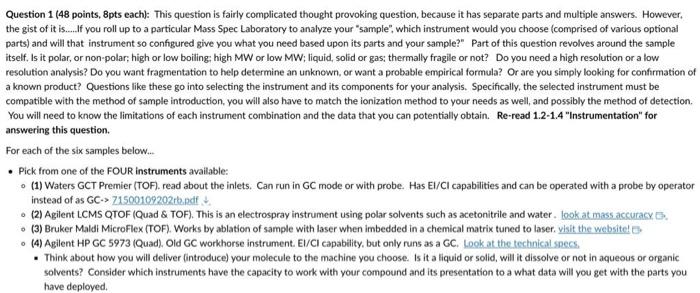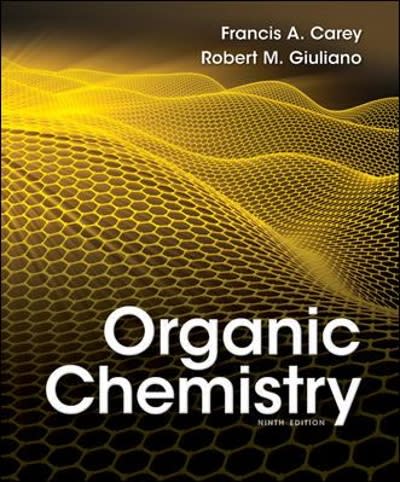Question 1 (48 points, 8 pts each): This question is fairly complicated thought provoking question, because it has separate parts and multiple answers. However, the gist of it is....If you roll up to a particular Mass Spec Laboratory to analyze your "sample", which instrument would you choose (comprised of various optional parts) and will that instrument so configured give you what you need based upon its parts and your sample?" Part of this question revolves around the sample itself. Is it polar, or non-polar; high or low boiling: high MW or low MW; liquid, solid or gas: thermally fragile or not? Do you need a high resolution or a low resolution analysis? Do you want fragmentation to help determine an unknown, or want a probable empirical formula? Or are you simply looking for confirmation of a known product? Questions like these go into selecting the instrument and its components for your analysis. Specifically, the selected instrument must be compatible with the method of sample introduction, you will also have to match the ionization method to your needs as well, and possibly the method of detection. You will need to know the limitations of each instrument combination and the data that you can potentially obtain. Re-read 1.2-1.4 "Instrumentation" for answering this question. For each of the six samples below... - Pick from one of the FOUR instruments available: - (1) Waters GCT Premier (TOF). read about the inlets. Can run in GC mode or with probe. Has El/Cl capabilities and can be operated with a probe by operator instead of as GC-7 71500109202 thepdf +. - (2) Agilent LCMS QTOF (Quad \& TOF). This is an electrospray instrument using polar solvents such as acetonitrile and water. look at mass accuracy E. - (3) Bruker Maldi MicroFlex (TOF). Works by ablation of sample with laser when imbedded in a chemical matrix tuned to laser. yisit the website! G - (4) Agilent HP GC 5973 (Quad), Old GC workhorse instrument. El/Cl capability, but only runs as a GC. Look. at the technical specs. - Think about how you will deliver (introduce) your molecule to the machine you choose. Is it a liquid or solid, will it dissolve or not in aqueous or organic solvents? Consider which instruments have the capacity to work with your compound and its presentation to a what data will you get with the parts you have deployed. Question 1 (48 points, 8 pts each): This question is fairly complicated thought provoking question, because it has separate parts and multiple answers. However, the gist of it is....If you roll up to a particular Mass Spec Laboratory to analyze your "sample", which instrument would you choose (comprised of various optional parts) and will that instrument so configured give you what you need based upon its parts and your sample?" Part of this question revolves around the sample itself. Is it polar, or non-polar; high or low boiling: high MW or low MW; liquid, solid or gas: thermally fragile or not? Do you need a high resolution or a low resolution analysis? Do you want fragmentation to help determine an unknown, or want a probable empirical formula? Or are you simply looking for confirmation of a known product? Questions like these go into selecting the instrument and its components for your analysis. Specifically, the selected instrument must be compatible with the method of sample introduction, you will also have to match the ionization method to your needs as well, and possibly the method of detection. You will need to know the limitations of each instrument combination and the data that you can potentially obtain. Re-read 1.2-1.4 "Instrumentation" for answering this question. For each of the six samples below... - Pick from one of the FOUR instruments available: - (1) Waters GCT Premier (TOF). read about the inlets. Can run in GC mode or with probe. Has El/Cl capabilities and can be operated with a probe by operator instead of as GC-7 71500109202 thepdf +. - (2) Agilent LCMS QTOF (Quad \& TOF). This is an electrospray instrument using polar solvents such as acetonitrile and water. look at mass accuracy E. - (3) Bruker Maldi MicroFlex (TOF). Works by ablation of sample with laser when imbedded in a chemical matrix tuned to laser. yisit the website! G - (4) Agilent HP GC 5973 (Quad), Old GC workhorse instrument. El/Cl capability, but only runs as a GC. Look. at the technical specs. - Think about how you will deliver (introduce) your molecule to the machine you choose. Is it a liquid or solid, will it dissolve or not in aqueous or organic solvents? Consider which instruments have the capacity to work with your compound and its presentation to a what data will you get with the parts you have deployed







